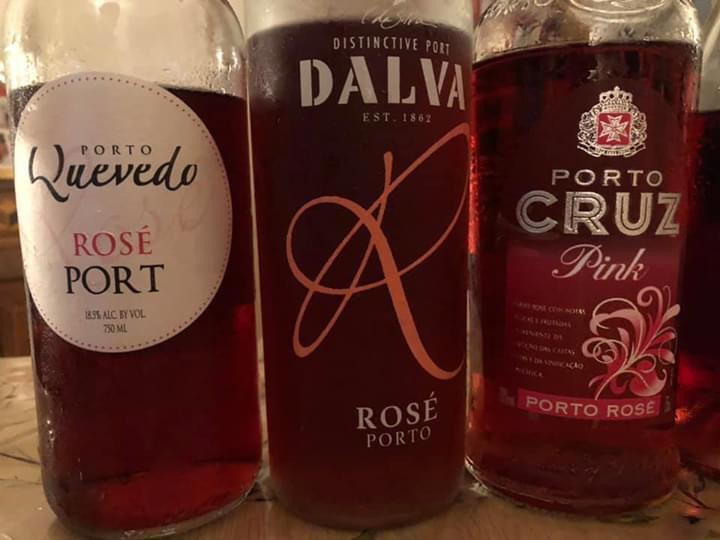Ernest Cockburn once said that the first duty of a Port wine is to be red, and the second is to be drunk. Pink Port has the quality and duty to be drunk, but what about the colour? From the very beginning, Port was designed to be RED. Starting with the so-called “Red Portugal” that British patriots were supposed to drink despite their love for the French Claret – certainly much paler, less tannic and lighter – in order to boycott the French export under Louis XIV’s rule. Attracted by lower duties on Portuguese wine, these Englishmen abandoned the Claret and crafted a wine for their taste source by merchants from the steep, unfriendly and scattered terraces of the mighty Douro Valley. In 1678, two of these merchants tasting such an unusual fortified wine at the Abbey of Lamego, eventually baptised it with the name it still bares: Port. Few is known about what they actually drunk that night with the abbot, but quickly afterwards “Red Oporto” was trumpeted everywhere within the British community of the city. It was supposed to be “deep, bright, strong, fresh and neat”.
The Brits’ thirst for this wine which was meant to have a “fiery spirit like gunpowder alight, the colour of the ink, the sweetness of Brazil and the aromas of India” together with the rise of annual shipments led to the adulteration of its production. The use of elderberry (baga de sabugueiro) became widespread in order to enforce the colour of the wines, so again, Port was supposed to be very “RED”. When Pombal delimited the area with the pombaline stones, the best plots, those for the Feitoria were meant to give the deepest wines that needed no other products, either “baga”, spices or sugar to make them alike the description above.
The British taste rapidly focused on what would eventually become a Vintage profile. Even though the first Vintages (we are speaking here about wines from around 1765-1775) were certainly lighter in style, with longer oak maturing and probably of a paler colour, they were still very RED. The first Vintage of a real certainty is the so-called “Waterloo Vintage” – 1815. The archetype however seems to be 1820 that used to have “plenty of crust and plenty of colour”. However, even before these two fantastic Vintages, legend has it the Vice-admiral Nelson draw his strategy for Trafalgar battle in 1805 with his finger dipped in a glass of Port wine. In order to sketch a plan on a table top, this wine was for sure very deeply coloured, and of course RED. Not to mention the celebration ball gave at the Factory House on the 11 November 1811, they for sure drank some worthy Vintages or what was supposed to be a Vintage then, to match the eleven- courses menu.
The rise of the White Port by the end of the 19th century and its tremendous history until recent changes in 2005 will be the subject of another chronical. Besides this “other colour” long seen as a lesser shade, Port remained eminently RED, either wooded or bottle-aged.
It is thanks to Croft (www.croftpink.com) that a new colour is born in 2008. Initially classified as a “light ruby”, this pink fever spread from a shipper to another, reached the producers and eventually the marketplace where the young consumer easily adopted this controversial Port. Now, many produce rosé or Pink Port, playing upon shades that range from pale/ medium salmon to light ruby, packaging that brakes the codes of traditional Port and flavours that vary from red fruits, to flowery and ethereal notes down to regressive bubble gum and allsorts that get us back to childhood. Well actually they all brink us back to a certain “madeleine de Proust”, as all this flavours are so close to a certain gourmandise level reminding summer holidays, granny’s fruit tarte, candies and jams, blossomy fields, a scent of happiness.
The challenge was to catch all these flavours without tannins or too much phenolics. Most of these pink goodies undergo maceration or bleeding techniques. Both are more difficult to master in products that have to stick to a house style year after year, especially that rosé Port is usually the wine of the vintage and benefits from reductive maturing (stainless steel mainly). Bleeding is maybe the most difficult and controversial, especially in terms of colour intensity.
Even though the same grape varieties that give red Port also give Rosé by the means of these techniques, the work is extremely meticulous to select fresher plots and aspects, best blend of varieties, perfect ripening moment both in terms of sugar and phenolics in order to make a proper pink.
The riper the fruit, the quicker the juice darkens, the quicker and warmer the maceration, the lower the aromas’ intensity and acidity of the wine, while too low temperature maceration can lead to herbaceous extraction and unwanted harsh phenolics. There’s the winemaker’s art.
Then come the quality of the aguardente as for all the Ports generally speaking and the precise time to add it. Pink Port is sweet or sometimes medium sweet but getting to the drier or sweeter areas can be dangerous for the balance. Nobody wants a cloggy pink, nor a tight and firm one.
Temperature control during fermentation is not an issue anymore, but the use of new technologies should not push the pink Port into the vulgar confected, bubble-gum aromatic area either. 17-18°C temperature is a good compromise, otherwise too much esters appear in the lower range and or fruity and floral scents fade in the higher sector.
This is maybe one of the most technical Ports to craft, the easiest to spoil and the most difficult to push to pinnacle. And all these for one of the most common use: served chilled, over ice, either as a standalone pre-dinner dink or as a cocktail base… I personally believe there is much more to do with this category. Follow my episodes for the #portwinehour to get more ideas, recipes, pairing, cocktails and more! Until then, enjoy some of my recent tasting notes:

1. Porto Quevedo Rosé 18,5%
Deep pink to light ruby. Nose is clean, of a medium intensity. Aguardente is present, generous. Then come notes of sour cherry, cranberry, and cherry complimented by a light leafy touch, some kirsch and cherry pit on the background. Sweet, medium/ medium minus acidity, alcohol is medium plus to high and warming, texture is silky, with medium plus phenolics, flavours feel more intense on the palate, offering cherry, cherry pit, like kirsch. Medium finish with some brandied cherry notes on the aftertaste. Medium plus to full bodied. Good.
2. Dalva Rosé 19%
Deep salmon pink, to pale garnet. Nose is clean, medium plus intensity, showing pomegranate, floral notes such as iris, and cherry, with a crunchy red apple touch. Sweet, alcohol is high with a medium plus feel, acidity is medium, texture is velvety, medium minus phenolics, flavours are intense and fresh, showing pomegranate, flowers, herbal notes on the medium finish. Medium plus body. Very good.

3. Cruz Rosé 19%
Medium pink with violet hues. Nose is clean and airy, almost ethereal, with notes of cherry, cherry pit, balsamic herbs, and strawberry. Medium sweet. Acidity is medium minus, alcohol is high, tannins are light/ medium minus, slightly bitter finish, but its intense flavours of strawberry, cherry pit, all sorts, hibiscus make that quite pleasant and salivating. Good/ Very good.
4. Croft Rosé 19,5%
Deep pink with violet hues, almost pale ruby. Nose is clean and pronounced, with vibrant cherry, sour cherry, cherry pit, flowers, in an almost airy style. Sweet, juicy, velvety, medium acidity which stays very refreshing, medium phenolics to plus, high integrated alcohol, giving a smooth mid-palate, intensely scented with cherry, pomegranate. The finish is spicy, juicy, long with a touch of liquorice, and pepper. Very good/ Outstanding

5. Barao de Vilar Rosé 19,5%
Medium pink/ deep salmon. Nose is medium, clean, with warming aguardente. Creamy, showing hints of white chocolate and strawberry, pomegranate and resin. Sweet, alcohol is high, generous, acidity is diminished. Phenolics are medium plus, quite extractive. With a bitter touch, warming, the chocolate-like finish is moderate and notes of resin come on the aftertaste. Good.
6. Dow’s Rosé 19,5%
Medium coral. Nose is reduced, with some herbal, stony, iodine character. Then come raspberry, strawberry, salinity. Medium dry, alcohol is medium plus, acidity is medium, lean, silky, and winey, with a slightly bitter finish, and few phenolics. Diminished flavours and medium aftertaste. Medium bodied. The only to have a classic cork closure, the most difficult to understand, the closest to wine. Good.
All the wines were tasted blind in Chef&Sommelier Reveal’Up Soft 30cl glasses. Wines ready to drink, without any benefit from further aging. Best enjoyed this summer, just follow my episodes to tell you how!
